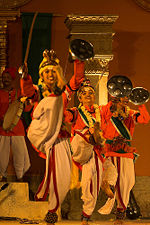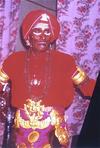
Veeragase
Encyclopedia


Karnataka
Karnataka , the land of the Kannadigas, is a state in South West India. It was created on 1 November 1956, with the passing of the States Reorganisation Act and this day is annually celebrated as Karnataka Rajyotsava...
, India
India
India , officially the Republic of India , is a country in South Asia. It is the seventh-largest country by geographical area, the second-most populous country with over 1.2 billion people, and the most populous democracy in the world...
. It is a vigorous dance based on Hindu mythology
Hindu mythology
Hindu religious literature is the large body of traditional narratives related to Hinduism, notably as contained in Sanskrit literature, such as the Sanskrit epics and the Puranas. As such, it is a subset of Nepali and Indian culture...
and involves very intense energy-sapping dance movements. Veeragase is one of the dances demonstrated in the Dasara
Mysore Dasara
Mysore Dasara is the Nadahabba of the state of Karnataka. It is also called Navaratri and is a 10-day festival with the last day being Vijayadashami, the most auspicious day of Dasara. Dasara usually falls in the month of September or October...
procession held in Mysore. This dance is performed during festivals and mainly in the Hindu months of Shravana and Karthika.
Mythology
Veeragase gets its name from the HinduHindu
Hindu refers to an identity associated with the philosophical, religious and cultural systems that are indigenous to the Indian subcontinent. As used in the Constitution of India, the word "Hindu" is also attributed to all persons professing any Indian religion...
legendary warrior, Veerabhadra
Veerabhadra
Veerabhadra is a Telugu film released on 29 April 2006 and was directed by AS Ravi Kumar Chowdary. Balakrishna plays the lead role. For the first time, Tanushree Dutta appears in a Telugu film. Sada plays the Second Heroine in the movie.One of the Biggest disasters of Tollywood and Bala krrishna...
. According to a legend, the Hindu God Shiva
Shiva
Shiva is a major Hindu deity, and is the destroyer god or transformer among the Trimurti, the Hindu Trinity of the primary aspects of the divine. God Shiva is a yogi who has notice of everything that happens in the world and is the main aspect of life. Yet one with great power lives a life of a...
was married to Dakshayini, whose father Daksha was against this marriage and hence bore enmity with Shiva
Shiva
Shiva is a major Hindu deity, and is the destroyer god or transformer among the Trimurti, the Hindu Trinity of the primary aspects of the divine. God Shiva is a yogi who has notice of everything that happens in the world and is the main aspect of life. Yet one with great power lives a life of a...
. When he performed a yagna, he invited all the Gods except Shiva
Shiva
Shiva is a major Hindu deity, and is the destroyer god or transformer among the Trimurti, the Hindu Trinity of the primary aspects of the divine. God Shiva is a yogi who has notice of everything that happens in the world and is the main aspect of life. Yet one with great power lives a life of a...
. Much against Shiva
Shiva
Shiva is a major Hindu deity, and is the destroyer god or transformer among the Trimurti, the Hindu Trinity of the primary aspects of the divine. God Shiva is a yogi who has notice of everything that happens in the world and is the main aspect of life. Yet one with great power lives a life of a...
's wishes, Dakshayini went to the yagna uninvited and was insulted by Daksha. Unable to bear the insults, Dakshayini jumped into the sacrificial fire. Hearing this news, Shiva
Shiva
Shiva is a major Hindu deity, and is the destroyer god or transformer among the Trimurti, the Hindu Trinity of the primary aspects of the divine. God Shiva is a yogi who has notice of everything that happens in the world and is the main aspect of life. Yet one with great power lives a life of a...
got very angry and started to perform the Tandava
Tandava
' or ', the divine art form, is a dance performed by the god Shiva, who is revered by Hindus. According to Hindu mythology, Shiva’s Tandava is a vigorous dance that is the source of the cycle of creation, preservation and dissolution...
dance which created turmoil in the world. When one of the sweat drops from Shiva
Shiva
Shiva is a major Hindu deity, and is the destroyer god or transformer among the Trimurti, the Hindu Trinity of the primary aspects of the divine. God Shiva is a yogi who has notice of everything that happens in the world and is the main aspect of life. Yet one with great power lives a life of a...
fell on to the earth, it gave rise to the warrior, Veerabhadra who went to Daksha's yagna, disrupted it and killed Daksha. When Dakshas wife pleaded mercy, he regained his life. This story is narrated by the dancers performing Veeragase.
Performers
The performers of Veeragase are called Lingadevaru and are devotees of ShivaShiva
Shiva is a major Hindu deity, and is the destroyer god or transformer among the Trimurti, the Hindu Trinity of the primary aspects of the divine. God Shiva is a yogi who has notice of everything that happens in the world and is the main aspect of life. Yet one with great power lives a life of a...
. The dancers put on a white traditional headgear and a bright red coloured dress. They also adorn themselves with a necklace made of Rudraksha
Rudraksha
Rudraksha Rudraksha Rudraksha (also Rudraksh; Sanskrit: ("Rudra's tears") is a large evergreen broad-leaved tree whose seed is traditionally used for prayer beads in Hinduism. The seed is borne by several species of Elaeocarpus, with E. ganitrus being the principal species used in the making of a...
beads, a hip-belt called rudra muke, an ornament resembling a snake and worn around the neck called Nagabharana and anklets. The dancers smear vibhooti on their foreheads, ears and eyebrows. They carry a wooden plaque of Lord Veerabhadra in their left hand and a sword in their right hand.
Performance
The dance trope usually consists of two, four or six members. A lead singer in the troupe narrates the story of Daksha yajnaYajna
In Hinduism, yajna is a ritual of sacrifice derived from the practice of Vedic times. It is performed to please the gods or to attain certain wishes...
as the dance is being performed. A huge decorative pole called Nandikolu which has an orange flag at the top is held by one of the dancers. Traditional percussion instruments called sambal and dimmu lend music to the dance. Cymbal
Cymbal
Cymbals are a common percussion instrument. Cymbals consist of thin, normally round plates of various alloys; see cymbal making for a discussion of their manufacture. The greater majority of cymbals are of indefinite pitch, although small disc-shaped cymbals based on ancient designs sound a...
s and shehnai
Shehnai
The shehnai, shahnai, shenai or mangal vadya, is an aerophonic instrument, a double reed conical oboe, common in North India, West India and Pakistan, made out of wood, with a metal flare bell at the end...
and other instruments like karadi and chamala are also used. The dance also involves a ritualistic piercing of a needle across the mouth

